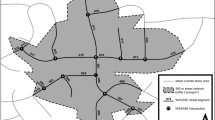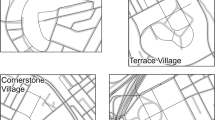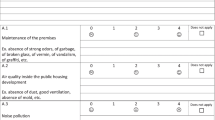Abstract
Street-level environment characteristics influence the health behaviors and safety of urban residents, and may particularly threaten health within informal communities. However, available data on how such characteristics vary within and among informal communities is limited. We sought to adapt street audit strategies designed to characterize the physical environment for use in a large informal community, Rio das Pedras (RdP) located in Rio de Janeiro, Brazil. A smartphone-based systematic observation protocol was used to gather street-level information for a high-density convenience sample of street segments (N = 630, estimated as 86% of all street segments in the community). We adapted items related to physical disorder and physical deterioration. Measures selected to illustrate the approach include the presence of the following: (1) low-hanging or tangled wires, (2) litter, (3) structural evidence of sinking, and (4) an unpleasant odor. Intercept-only spatial generalized additive models (GAM) were used to evaluate and visualize spatial variation within the RdP community. We also examined how our estimates and conclusions about spatial variation might have been affected by lower-density sampling from random subsets street observations. Random subsets were selected to determine the robustness of study results in scenarios with sparser street sampling. Selected characteristics were estimated to be present for between 18% (unpleasant odor) to 59% (low-hanging or tangled wires) of the street segments in RdP; estimates remain similar (± 6%) when relying on a random subset created to simulate lower-density spatial sampling. Spatial patterns of variation based on predicted probabilities across RdP differed by indicator. Structural sinking and low-hanging or tangled wires demonstrated relatively consistent spatial distribution patterns across full and random subset sample sizes. Smartphone-based systematic observations represent an efficient and potentially feasible approach to systematically studying neighborhood environments within informal communities. Future deployment of such tools will benefit from incorporating data collection across multiple time points to explore reliability and quantify neighborhood change. These tools can prove useful means to assess street-level exposures that can be modifiable health determinants across a wide range of informal urban settings. Findings can contribute to improved urban planning and provide useful information for identifying potential locations for neighborhood-scaled interventions that can improve living conditions for residents in Rio das Pedras.




Similar content being viewed by others
References
Molnar BE, Gortmaker SL, Bull FC, Buka SL. Unsafe to play? Neighborhood disorder and lack of safety predict reduced physical activity among urban children and adolescents. Am J Health Promot. 2004;18(5):378–86.
Elo IT, Mykyta L, Margolis R, Culhane JF. Perceptions of neighborhood disorder: the role of individual and neighborhood characteristics. Soc Sci Q. 2009;90(5):1298–320.
Diez Roux AV, Mair C. Neighborhoods and health. Ann N Y Acad Sci. 2010;1186(1):125–45.
Lovasi GS, Schwartz-Soicher O, Quinn JW, Berger DK, Neckerman KM, Jaslow R, et al. Neighborhood safety and green space as predictors of obesity among preschool children from low-income families in New York City. Prev Med. 2013;57(3):189–93.
Wilson JQ. Kelling GLJAm. Broken windows. 1982;249(3):29–38.
Surratt HL, Kurtz SP, Levi-Minzi MA, Chen M. Environmental influences on HIV medication adherence: the role of neighborhood disorder. Am J Public Health. 2015;105(8):1660–6.
Diez Roux AV, et al. J Urban Health. 2003;80(4):569–89.
Latkin CA, Curry AD. Stressful neighborhoods and depression: a prospective study of the impact of neighborhood disorder. J Health Soc Behav. 2003;44(1):34–44.
Sampson RJ, Raudenbush SW. Systematic social observation of public spaces: a new look at disorder in urban neighborhoods. Am J Sociol. 1999;105(3):603–51.
Caughy MO, O’Campo PJ, Patterson J. A brief observational measure for urban neighborhoods. Health Place. 2001;7(3):225–36.
Schaefer-McDaniel N, O'Brien Caughy M, O'Campo P, Gearey W. Examining methodological details of neighbourhood observations and the relationship to health: a literature review. Soc Sci Med. 2010;70(2):277–92.
Curtis A, Blackburn JK, Widmer JM, Morris JG Jr. A ubiquitous method for street scale spatial data collection and analysis in challenging urban environments: mapping health risks using spatial video in Haiti. Int J Health Geogr. 2013;12:21.
Rundle AG, Bader MDM, Richards CA, Neckerman KM, Teitler JO. Using Google Street View to audit neighborhood environments. Am J Prev Med. 2011;40(1):94–100.
Mooney SJ, Bader MDM, Lovasi GS, Neckerman KM, Teitler JO, Rundle AG. Validity of an ecometric neighborhood physical disorder measure constructed by virtual street audit. Am J Epidemiol. 2014;180(6):626–35.
Odgers CL, Caspi A, Bates CJ, Sampson RJ, Moffitt TE. Systematic social observation of children’s neighborhoods using Google Street View: a reliable and cost-effective method. J Child Psychol Psychiatry. 2012;53(10):1009–17.
Badland HM, Opit S, Witten K, Kearns RA, Mavoa S. Can virtual streetscape audits reliably replace physical streetscape audits? J Urban Health. 2010;87(6):1007–16.
Bader MDM, Mooney SJ, Lee YJ, et al. Development and deployment of the computer assisted neighborhood visual assessment system (CANVAS) to measure health-related neighborhood conditions. Health Place. 2015;31:163–72.
Clarke P, Ailshire J, Melendez R, Bader M, Morenoff J. Using Google Earth to conduct a neighborhood audit: reliability of a virtual audit instrument. Health Place. 2010;16(6):1224–9.
Marcano Belisario JS, Jamsek J, Huckvale K, O'Donoghue J, Morrison CP, Car J. Comparison of self-administered survey questionnaire responses collected using mobile apps versus other methods. Cochrane Database Syst Rev. 2015;7:Mr000042.
Teacher AGF, Griffiths DJ, Hodgson DJ, Inger R. Smartphones in ecology and evolution: a guide for the app-rehensive. Ecol Evol. 2013;3(16):5268–78.
Tomlinson M, Solomon W, Singh Y, Doherty T, Chopra M, Ijumba P, et al. The use of mobile phones as a data collection tool: a report from a household survey in South Africa. BMC Med Inform Decis Mak. 2009;9:51–1.
Belavy D. A mobile telephone-based SMS and internet survey system for self-assessment in Australian anaesthesia: experience of a single practitioner. Anaesth Intensive Care. 2014;42(6):771–6.
Hofland ACL, Devilee J, van Kempen E, den Broeder L. Resident participation in neighbourhood audit tools—a scoping review. Eur J Pub Health. 2018;28(1):23–9.
Costa DAS, Mingoti SA, Andrade ACS, Xavier CC, Proietti FA, Caiaffa WT. Indicadores dos atributos físicos e sociais da vizinhança obtidos pelo método de Observação Social Sistemática. J Cadernos de saude publica. 2017;33:e00026316.
Snyder RE, Jaimes G, Riley LW, Faerstein E, Corburn J. A comparison of social and spatial determinants of health between formal and informal settlements in a large metropolitan setting in Brazil. J Urban Health. 2014;91(3):432–45.
Zulaika G, Behrooz MR, Gupta R, et al. A community health diagnosis of Rio das Pedras. New York, NY: Mailman School of Public Health, Columbia University; 2016.
Alderman K, Turner LR, Tong S. Floods and human health: a systematic review. Environ Int. 2012;47:37–47.
Spatial Networks Inc. Fulcrum App. Available at: https://www.fulcrumapp.com/. Accessed 30 March 2018.
Zenk SN, Schulz AJ, Mentz G, et al. Inter-rater and test–retest reliability: methods and results for the neighborhood observational checklist. Health Place. 2007;13(2):452–65.
Heukelbach J, de Oliveira FA, Kerr-Pontes LR, Feldmeier H. Risk factors associated with an outbreak of dengue fever in a favela in Fortaleza, North-East Brazil. Tropical Med Int Health. 2001;6(8):635–42.
Costa F, Wunder EA Jr, De Oliveira D, et al. Patterns in Leptospira shedding in Norway rats (Rattus norvegicus) from Brazilian slum communities at high risk of disease transmission. PLoS Negl Trop Dis. 2015;9(6):e0003819.
Ajibade I, McBean G. Climate extremes and housing rights: a political ecology of impacts, early warning and adaptation constraints in Lagos slum communities. Geoforum. 2014;55:76–86.
Lins C. Providing electricity to Rio de Janeiro's favelas. The Guardian, 2014.
Mooney SJ, Sheehan DM, Zulaika G, Rundle AG, McGill K, Behrooz MR, et al. Quantifying distance overestimation from global positioning system in urban spaces. Am J Public Health. 2016;106(4):651–3.
Wood SN. Generalized additive models: an introduction with R: chapman and hall/CRC; 2006. Wood, SN: Boca Raton, Florida.
Honório NA, Nogueira RMR, Codeço CT, Carvalho MS, Cruz OG, de Avelar Figueiredo Mafra Magalhães M, et al. Spatial evaluation and modeling of dengue seroprevalence and vector density in Rio de Janeiro, Brazil. PLoS Negl Trop Dis. 2009;3(11):e545.
Reis RB, Ribeiro GS, Felzemburgh RD, et al. Impact of environment and social gradient on Leptospira infection in urban slums. PLoS Negl Trop Dis. 2008;2(4):e228.
R Core Team. R: A language and environment for statistical computing. 2018. Vienna, Austria. http://www.R-project.org/.
Light. Light Homepage. Available at: https://www.theguardian.com/sustainable-business/providing-electricity-rio-de-janeiro-favelas. Accessed 30 March 2018.
Hartung C, Lerer A, Anokwa Y, Tseng C, Brunette W, Borriello G. Open data kit: tools to build information services for developing regions. Paper presented at: Proceedings of the 4th ACM/IEEE international conference on information and communication technologies and development, 2010.
Weisskopf MG, Webster TF. Trade-offs of personal versus more proxy exposure measures in environmental epidemiology. Epidemiology. 2017;28(5):635–43.
Quistberg DA, Diez Roux AV, Bilal U, et al. Building a data platform for cross-country urban health studies: the SALURBAL study. November 21 2018. J Urban Health.
Hoeben EM, Steenbeek W, Pauwels LJR. Measuring disorder: observer bias in systematic social observations at streets and neighborhoods. J Quant Criminol. 2016:1–29.
Acknowledgments
Thank you to the team in Rio de Janeiro who were crucial to making the larger project successful, particularly Debora de Pina Castiglione, Paulo Barroca, and other colleagues at Fundação Oswaldo Cruz; Claudia Franco Correa and her team at the Center for Citizenship and Investigation in Rio das Pedras; and the six trained resident data collectors. Thank you to the Built Environment and Health Research Group at Columbia University for partnership and technical input on state of the art urban health mapping. We would like to thank the Columbia Global Center in Rio de Janeiro and Columbia University’s Studio-X in Rio for their help in making the connections necessary to complete this work. Thank you to all project investigators whose expertise made this project stronger and more rewarding: Drs. Kartik Chandran, Ryan Demmer, Gustavo Azenha, and Barun Mathema. Moreover, thank you to our wonderful research team of students: Melika Behrooz, Richa Gupta, Matheus Braz, Eva Siegel, Melanie Askari, and Charlene Goh whose efforts sustained this project through its completion. Special thanks also to Fulcrum and Spatial Networks, Inc., for providing free academic licenses and specifically Bryan McBride, Integrations Manager at Fulcrum. Special thanks go to Medtronic Philanthropy (FY14–000483), the Columbia University Urban+Health Initiative at the Mailman School of Public Health, and a generous pledge and gift from Dana and David Dornsife to the Drexel University Dornsife School of Public Health, whose generous funding support made this study possible.
Author information
Authors and Affiliations
Corresponding author
Additional information
Publisher’s Note
Springer Nature remains neutral with regard to jurisdictional claims in published maps and institutional affiliations.
Electronic supplementary material
ESM 1
(DOCX 3356 kb)
Rights and permissions
About this article
Cite this article
Remigio, R.V., Zulaika, G., Rabello, R.S. et al. A Local View of Informal Urban Environments: a Mobile Phone-Based Neighborhood Audit of Street-Level Factors in a Brazilian Informal Community. J Urban Health 96, 537–548 (2019). https://doi.org/10.1007/s11524-019-00351-7
Published:
Issue Date:
DOI: https://doi.org/10.1007/s11524-019-00351-7




